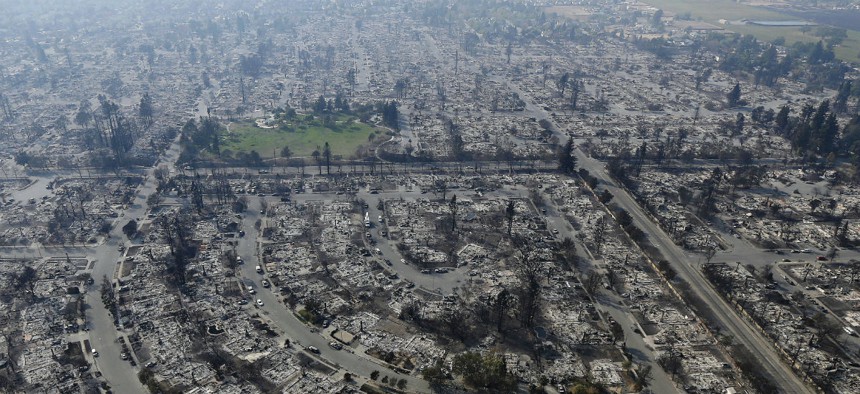
An aerial view of burned homes in Santa Rosa, California, as of Wednesday. Jeff Chiu/AP
Federal Agencies Significantly Ramp Up California Wildfire Response
Federal personnel fighting fires in California tripled in a matter of days.
There are now 1,500 federal personnel fighting wildfires in California, a dramatic increase from just a few days ago.
Fires across northern California have killed at least 23 people, destroyed hundreds of structures and forced tens of thousands of residents to evacuate. Federal agencies—led primarily by the Forest Service—had just 500 firefighters deployed as of Tuesday, but the number has climbed as the agency has boosted the staff assisting state and local authorities.
The Forest Service, buoyed by the Bureau of Land Management and others, now has 800 firefighters in northern California helping contain fires on lands controlled by state and local jurisdictions. The rest of its firefighters were working to put out a barrage of fires on federal National Forests. The agency recently upgraded its preparedness level to four to reflect its boosted assistance, one short of the level signifying a full allocation of resources.
Bob Baird, the director of fire and aviation for the Forest Service’s Pacific Southwest region, is overseeing the federal response to the wildfire outbreak. On Thursday afternoon, he and his family received an evacuation order for their home.
“It’s affecting our federal employees as we speak,” Baid said, noting some of his colleagues are already without power and water.
In addition to personnel, the Forest Service has sent more than 50 all-terrain fire engines, three fire fighting bulldozers, 19 fixed-wing aircraft and 14 water-dropping helicopters. The aircraft include large air tankers that drop retardant, as well as scoopers that gather water from a lake or reservoir and dump it on a fire. Its deployed personnel include 14 “hot-shot crews,” which Baird called the most highly trained firefighters in the federal system.
“The armada we bring is well beyond what a local government could ever fund and support,” Baird said. “They’d never be able to have that on a sustainable budget.”
BLM has sent three fire engines to assist with suppression efforts in Calistoga, a city in Napa Valley, California. Some BLM lands have already been burned while flames are approaching others, but a spokeswoman said the full damage to those areas has not yet been assessed as its efforts are focused on helping its partners protect local communities.
The Forest Service is also providing assistance with victims of the fires who have lost their homes or personal items by processing their requests for Fire Management Assistance Grants, which are ultimately paid out by the Federal Emergency Management Agency. President Trump signed an emergency declaration this week authorizing federal cost sharing as well as the fire grants. Trump has already sent a request to Congress for $576 million in additional funding for wildfire suppression as part of an emergency request for disaster relief appropriations.
The Forest Service has deployed about 75 of its California-based firefighters to Puerto Rico, who are currently assisting in the federal response to Hurricane Maria. The agency has redeployed some resources to California to help with wildfire suppression efforts, including 100 Nevada-based firefighters now in the embattled state. A team of agency firefighters are also currently deployed to Anaheim to help local authorities combat a wildfire there. The Forest Service maintains 24-hour staffing in southern California fire stations due to the frequency of wildfires in the area.
The recent spurt of wildfires comes at the end of a “very demanding fire season,” Baird said, noting his agency spent several weeks at the maximum preparedness level five already this year. Three Forest Service firefighters have passed away this year.
The firefighters generally work two weeks at at a time before taking two-to-three days off, for up to 16 hours per day.
“What we draw is people who are highly committed to the mission,” Baird said. “At the same time, this is very demanding, both on our employees and their families. We recognize that and we support them as best we can.”
Baird said their passion for the work helps his employees get through the difficult days.
“It’s probably the most demanding job in the federal workforce, right there with law enforcement,” he said “It’s exceptionally hot, demanding, physical work. But they love it.”
As for Baird himself, he—as of Wednesday afternoon—had not yet determined a plan for where he, his wife and his kids would stay as the one wildfire moved within just a few miles of his home.
“I just talked to my wife. She’s planning to move my family,” Baird said. “We’ve been evacuated before. I’ll work that out probably as soon as I get off the phone.”







